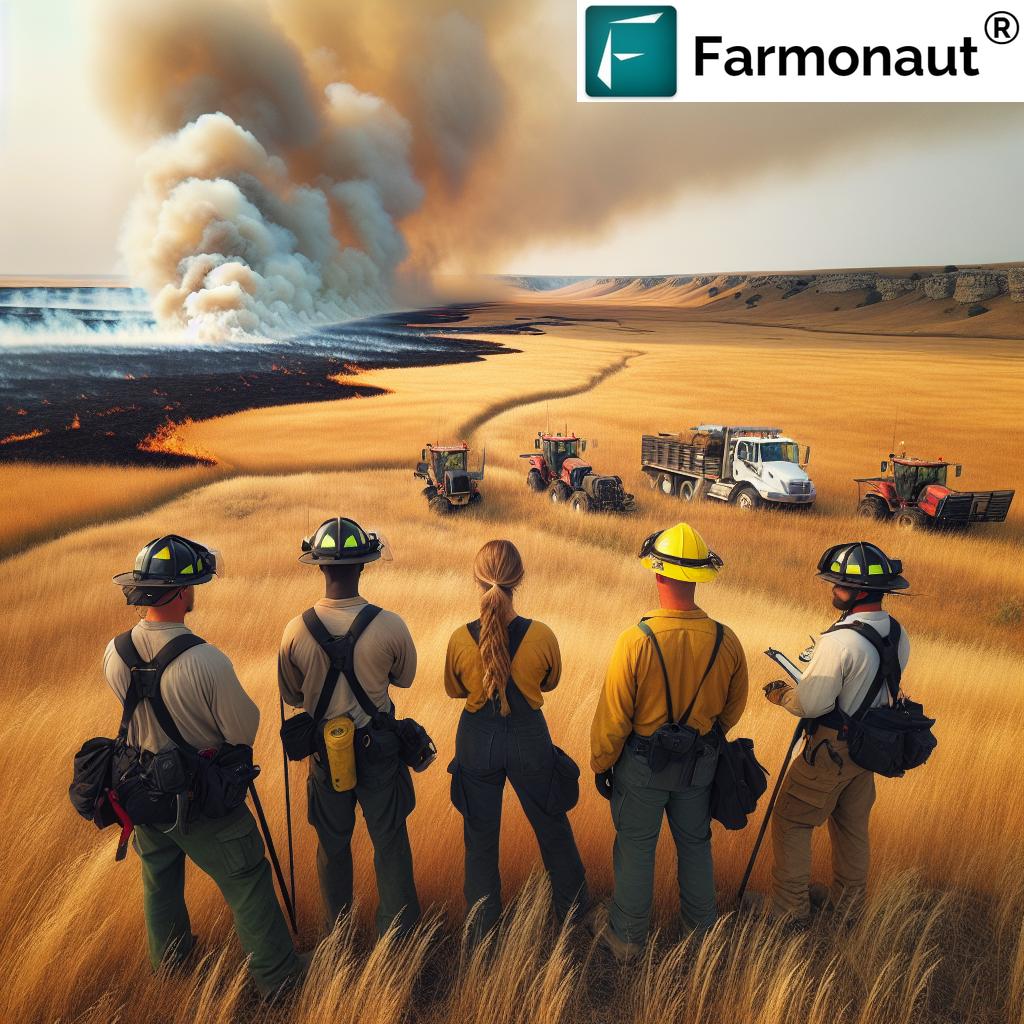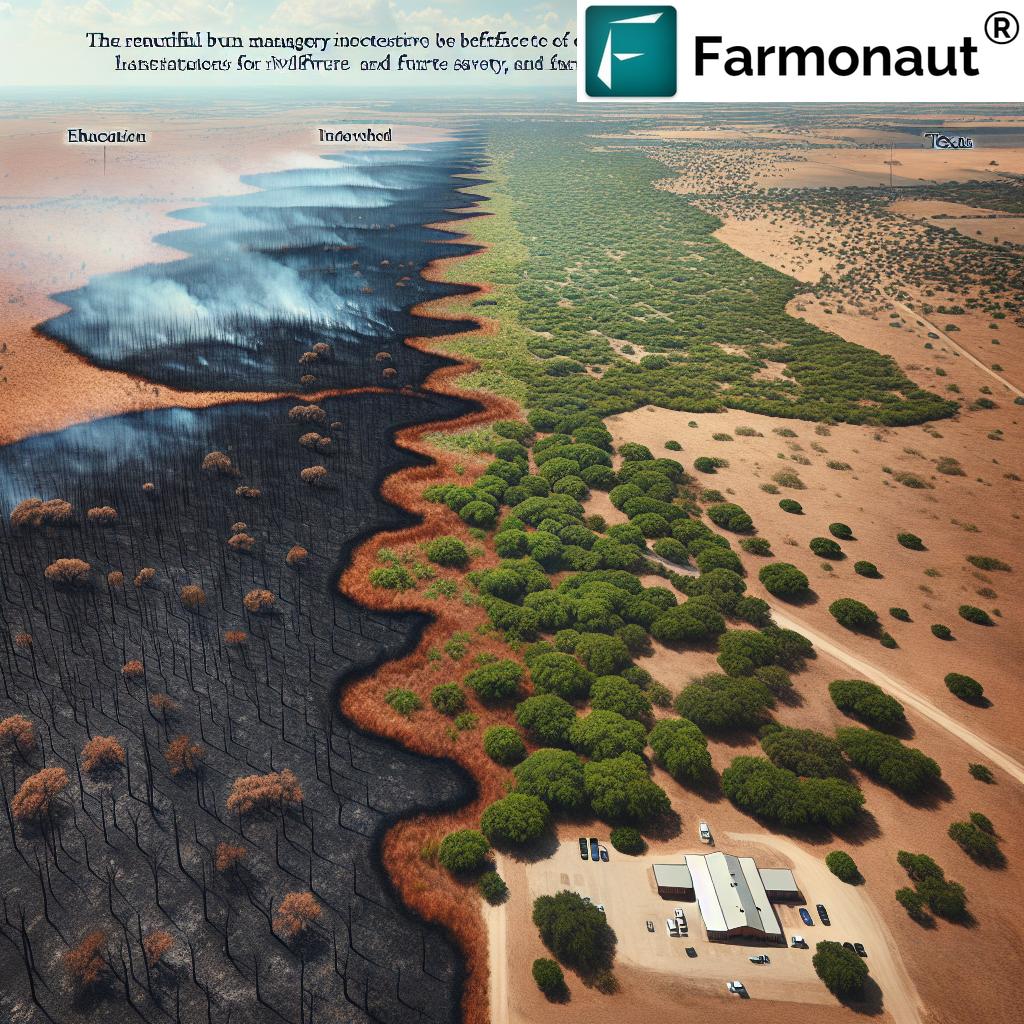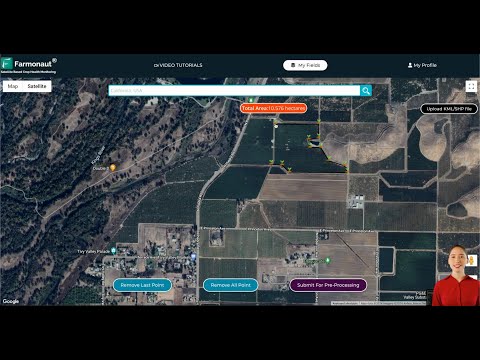Texas Prescribed Burn Management: Balancing Drought Mitigation and Wildfire Prevention
“Over 90% of Texas counties have implemented burn bans during severe drought conditions to prevent wildfires.”
In the vast expanse of Texas, where sprawling rangelands meet dense forests, the delicate balance between ecological health and fire safety is a constant challenge. As we navigate the complexities of prescribed burn management during Texas burn bans, we find ourselves at the intersection of tradition, science, and necessity. This comprehensive guide explores the intricate dance between maintaining fire safety practices and implementing crucial drought mitigation techniques in the Lone Star State.

Understanding Prescribed Burning in Texas
Prescribed burning, also known as controlled burning, is a time-honored practice in Texas agricultural land management. It’s a technique that mimics natural fire cycles, offering numerous benefits to ecosystems and agricultural operations alike. However, in a state prone to drought and wildfires, the practice requires careful consideration and expert management.
At Farmonaut, we recognize the importance of sustainable land management practices. While we specialize in satellite-based farm management solutions, we understand the critical role that prescribed burning plays in maintaining healthy ecosystems and productive agricultural lands. Our web application provides valuable insights into vegetation health and soil moisture, which can complement prescribed burning strategies.
The Challenges of Burn Bans in Texas
During periods of extreme drought, many Texas counties implement burn bans to prevent wildfires. These bans can pose significant challenges for landowners and agricultural professionals who rely on prescribed burning as a management tool. However, it’s crucial to understand that even during burn bans, exceptions can be made for essential burning activities.
- Federal and state agencies often receive exemptions for critical land management operations
- Educational institutions may be allowed to conduct research burns under controlled conditions
- Trained professionals with proper certifications can sometimes obtain permits for necessary burns
These Texas burn ban exceptions are designed to balance the need for fire safety with the ecological and agricultural benefits of controlled burning.
The Importance of Clear Criteria in Burn Ban Documentation
For counties implementing burn bans, clear and comprehensive documentation is essential. This documentation should outline:
- Specific conditions under which the ban is enacted
- Duration of the ban
- Criteria for potential exceptions
- Penalties for violations
By providing detailed information, counties can ensure that residents and professionals understand the rules and can plan accordingly. This clarity is crucial for maintaining public safety while allowing for necessary land management practices.
Recommended Requirements for Conducting Burns During Bans
When exceptions are granted for prescribed burns during ban periods, strict requirements must be followed to ensure safety and effectiveness. These may include:
- Detailed burn plans submitted for approval
- On-site presence of certified burn managers
- Adequate firefighting equipment and personnel
- Continuous monitoring of weather conditions
- Communication with local fire departments and authorities
These requirements help mitigate risks and ensure that burns are conducted responsibly, even under challenging conditions.

The Role of Education and Training in Sustainable Pasture Management
Education and training play a pivotal role in ensuring the safe and effective implementation of prescribed burning practices. Organizations like the Texas A&M AgriLife Extension Service offer valuable resources and training programs for landowners, ranchers, and agricultural professionals.
These programs cover topics such as:
- Fire ecology and behavior
- Burn plan development
- Safety protocols and equipment usage
- Legal considerations and liability issues
- Post-burn management and monitoring
By investing in education and training, we can create a community of knowledgeable practitioners who can safely implement prescribed burning as part of a comprehensive sustainable pasture management strategy.
At Farmonaut, we believe in the power of knowledge and technology to transform agriculture. Our API and API Developer Docs provide access to valuable satellite and weather data that can complement traditional land management practices.
Collaborative Efforts for Rural Fire Safety
Effective prescribed burn management during drought conditions requires collaboration between various stakeholders. Landowners, local officials, and government agencies must work together to develop and implement rural fire safety practices that protect communities while allowing for necessary land management activities.
Key collaborative efforts include:
- Establishing local prescribed burn associations
- Developing mutual aid agreements between fire departments
- Creating community wildfire protection plans
- Sharing resources and expertise across jurisdictions
These collaborative approaches help build resilience in rural communities and ensure that prescribed burning can be conducted safely, even under challenging conditions.
Wildlife Habitat Conservation Through Responsible Burning
Wildlife habitat conservation is a critical aspect of prescribed burning in Texas. When conducted properly, controlled burns can:
- Promote native plant species diversity
- Create openings for wildlife movement and foraging
- Control invasive plant species
- Improve habitat for endangered species
However, during drought conditions, extra care must be taken to ensure that burns do not negatively impact wildlife populations. This may involve adjusting the timing and intensity of burns to accommodate breeding seasons and migration patterns.
“Properly conducted prescribed burns can reduce wildfire fuel loads by up to 70% in Texas grasslands.”
Mitigating Wildfire Risks Through Proper Planning
While it may seem counterintuitive, prescribed burning is actually a powerful tool for wildfire prevention. By reducing fuel loads in a controlled manner, we can decrease the intensity and spread of potential wildfires. However, proper planning is essential to ensure that prescribed burns achieve their intended purpose without creating additional risks.
Key elements of effective wildfire risk mitigation through prescribed burning include:
- Comprehensive fuel load assessments
- Strategic placement of firebreaks and control lines
- Careful consideration of topography and prevailing winds
- Coordination with local fire departments and emergency services
- Post-burn monitoring and maintenance
By integrating these elements into prescribed burn plans, we can effectively reduce wildfire risks while promoting healthy ecosystems.
Resources for Counties: Sample Orders and Burn Plans
To assist counties in developing effective burn ban policies and procedures, various resources are available. These include:
- Sample burn ban orders that can be customized to local needs
- Templates for prescribed burn plans
- Checklists for burn ban implementation and enforcement
- Guidelines for creating exception criteria
These resources help ensure consistency across the state while allowing for local adaptations based on specific conditions and needs.
Optimizing Land Management During Critical Weather Conditions
Managing agricultural lands during drought conditions requires a delicate balance between conservation efforts and productivity. While prescribed burning may be restricted, other drought mitigation techniques can be employed to maintain land health and productivity:
- Implementing rotational grazing systems
- Utilizing drought-resistant crop varieties
- Enhancing soil moisture retention through mulching and cover cropping
- Investing in efficient irrigation systems
At Farmonaut, our satellite-based monitoring services can provide valuable insights into soil moisture levels and crop health, helping farmers and ranchers make informed decisions during critical weather conditions. Our Android app and iOS app put this powerful technology right at your fingertips.


The Future of Prescribed Burning in Texas
As we look to the future, the role of prescribed burning in Texas land management will continue to evolve. Climate change, shifting land use patterns, and advancing technologies will all influence how we approach this important practice. Key considerations for the future include:
- Integration of advanced weather forecasting and fire behavior modeling
- Development of more precise ignition and control techniques
- Enhanced training programs for burn managers and firefighters
- Greater public education and engagement on the benefits of prescribed burning
By staying at the forefront of these developments, Texas can continue to reap the benefits of prescribed burning while mitigating risks and protecting communities.
Prescribed Burn Management Comparison Table
| Criteria | Standard Practices | Drought Conditions Adaptations |
|---|---|---|
| Burn Authorization | Local fire department approval | County-level exception process |
| Safety Precautions | Standard firefighting equipment | Enhanced water resources, additional personnel |
| Weather Considerations | Moderate humidity, light winds | Stricter humidity and wind speed limits |
| Personnel Requirements | Certified burn manager + 2-3 assistants | Certified burn manager + 4-6 assistants |
| Equipment Needs | Basic fire suppression tools | Advanced suppression equipment, aerial support on standby |
| Habitat Impact | Moderate, planned disturbance | Minimal, focused on critical areas only |
| Wildfire Risk Mitigation | Reduce fuel loads by 50-60% | Strategic burns to create firebreaks, reduce fuel loads by 70%+ |
Conclusion: Balancing Act for a Resilient Texas
Navigating the complexities of prescribed burn management during Texas burn bans is undoubtedly challenging. However, by embracing a balanced approach that prioritizes safety, ecological health, and agricultural productivity, we can continue to harness the benefits of this time-honored practice even in the face of drought and wildfire risks.
As we move forward, collaboration, education, and technological innovation will be key to developing Texas agricultural policies that support responsible prescribed burning practices. By working together and leveraging the best available tools and knowledge, we can ensure that Texas lands remain healthy, productive, and resilient for generations to come.
At Farmonaut, we’re committed to supporting sustainable agricultural practices through our advanced satellite-based monitoring solutions. While we don’t directly engage in prescribed burning activities, our technology can provide valuable insights to complement these important land management strategies. Together, we can build a more sustainable and fire-resilient Texas.

Frequently Asked Questions (FAQ)
Q: What is prescribed burning?
A: Prescribed burning, also known as controlled burning, is a planned fire set intentionally for purposes such as forest management, farming, prairie restoration, or reducing wildfire risk.
Q: Why are burn bans implemented in Texas?
A: Burn bans are implemented during periods of drought or high fire danger to prevent wildfires and protect public safety.
Q: Can prescribed burns be conducted during a burn ban?
A: In some cases, exceptions may be granted for essential prescribed burns, but this requires special permission and strict adherence to safety protocols.
Q: How does prescribed burning help prevent wildfires?
A: Prescribed burns reduce fuel loads in a controlled manner, decreasing the intensity and spread of potential wildfires.
Q: What training is required to conduct prescribed burns in Texas?
A: Texas requires certified burn managers to oversee prescribed burns. Training programs are offered through various organizations, including the Texas A&M AgriLife Extension Service.



